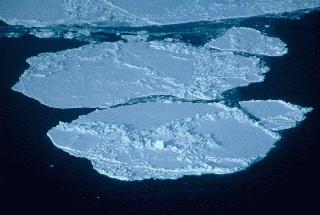David Barber (in the white hat) and Alex Langlois are sampling new ice in the Arctic. Dr. Barber is a prominent Arctic researcher and Alex was a graduate student at the University of Manitoba at the time of the photo. This picture was taken by Victoria Razina during a summer cruise in 2005.
Click on image for full size
Image taken by Victoria Razina
International Polar Year - and IPY's of the Past
2007-2008 has been made an International Polar Year or IPY. That means that scientists from over 30 countries will work together to study the Arctic and Antarctic. Would you like to study
penguins in Antarctica or
northern lights in the Arctic? If so, look at the official
IPY page often to see what exciting work is being done by scientists in the field!
Did you know that there have been IPY's in the past? The 1st IPY took place in 1882! Then 12 countries worked together to study the poles of the Earth.
The 2nd IPY took place in 1932. This time 40 countries were working together. They even made 40 permanent stations in the Arctic. Many of these are still manned and working!
In 1957, there was a International Geophysical Year (IGY). In that year, scientists studied polar science and many other Earth sciences too. Many important things were found by working together!
The theory of continental drift was confirmed.
For the first time scientists crossed the Antarctica continent measuring its total size. And permanent stations were made in Antarctica.
This text was adapted from text written by Maria Tsukernik who is a graduate student at University of Colorado-Boulder.
You might also be interested in:

The United States has dedicated a new scientific station at the geographic South Pole. This is the third station the United States has operated at the South Pole since 1957. The new station is called the
...more
Polar exploration includes the exploration of the Arctic and the Antarctic. The Arctic is the area around the Earth's north pole. Antarctica is a continent that surrounds the South Pole. When you think
...more
What Will You Find There? If you travel to the South Pole, you will find the continent of Antarctica surrounded by the Southern Ocean. The geographic South Pole is marked by a large sign that scientists
...more
Antarctica is the coldest, windiest, and driest continent on Earth. It is about one and a half times the size of the United States. Almost all of Antarctica is covered with a thick layer of ice called
...more
In the Arctic, you will find the Arctic Ocean surrounded by the continents of Europe, Asia, and North America. You will find the geographic North Pole and the magnetic North Pole there; both are in the
...more
Polar bears live in one of our planet’s most extreme environments, the Arctic . They thrive in the freezing cold. But because of global warming, polar bears might be in trouble. Scientists are studying
...more
Sea ice is frozen seawater. It floats on the oceans that are in Earth's polar regions. The salt in the seawater does not freeze. Very salty water gets trapped in the sea ice when it forms. The pockets
...more














